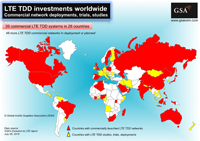 The latest Status of the Global LTE TDD Market Report published by the Global mobile Suppliers Association (GSA), confirms a rising number of operator commitments to LTE TDD (TD-LTE) network deployments, new commercial service launches, rapid expansion in the choice of user devices, especially smartphones, and accelerating subscriber growth.
The latest Status of the Global LTE TDD Market Report published by the Global mobile Suppliers Association (GSA), confirms a rising number of operator commitments to LTE TDD (TD-LTE) network deployments, new commercial service launches, rapid expansion in the choice of user devices, especially smartphones, and accelerating subscriber growth.
39 operators, which is around 1 in 8 LTE operators, have commercially launched LTE TDD (TD-LTE) systems in 26 countries. Another 48 operators are currently deploying or planning networks. Added to this are a number of operators who are undertaking technology trials and studies. GSA has calculated, therefore, that almost 120 operators globally are investing in LTE TDD.
LTE is an open standard developed by 3GPP and incorporates flexibility to operate in either paired (FDD Frequency Division Duplexing mode) or unpaired (TDD Time Division Duplexing mode) spectrum, using various channel bandwidths. The vast majority of the LTE standard is identical for both modes, and ensures maximum commonality of design and production economies of scale. The TDD mode of LTE is the most efficient and highest performing radio access network technology for operators with unpaired spectrum.
Within the current total of 39 commercially launched LTE TDD networks, 13 operators have launched converged systems, i.e., using both TDD and FDD mode in the networks. GSA confirms this is a growing industry trend. For example, some operators in India are deploying converged networks using LTE FDD 1800 MHz (band 3) and TDD 2.3 GHz (band 40) spectrum, which is a combination supported by 152 user terminals.
The devices ecosystem for the TDD mode is mature and has expanded rapidly. Within the total of 1,889 LTE user devices that have been introduced to the market, as recently confirmed by GSA, 530 products i.e. 28 percent of all LTE devices and 330 more than a year ago, can operate in the LTE TDD mode (TD-LTE). GSA confirms 85 device manufacturers have launched LTE TDD products.
Alan Hadden, president of GSA, said: "TDD operators are focusing more on personal mobility and the smartphone is the key segment. Recent progress has been excellent and 184 TDD smartphone products have now been announced, which is 87 percent more than the total in March 2014."
Bands 40 (2.3 GHz) and 38 (2.6 GHz) have the largest choice of TDD (TD-LTE) terminals, each band being supported by 68 per cent of all LTE TDD devices. Terminal support for band 39 is 38 percent, band 41 is 34 percent, and band 42 is 4.5 percent. Band 40 (2.3 GHz) is used in most commercially launched LTE networks currently. GSA forecasts that the TDD share of global LTE subscriptions, fuelled by its popularity in China with 14 million LTE TDD subscribers by end June 2014, will surge from around 5 percent n Q1 2014 to over 15 percent by end 2014. For more information visit: www.gsacom.com.
